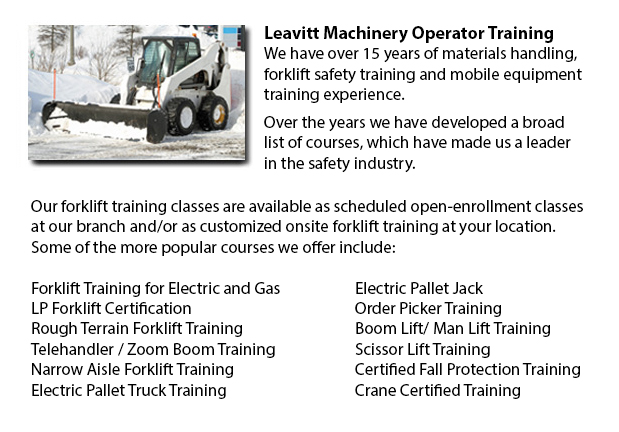
Mississauga Skid Steer Ticket - On a skid-steer loader, the lift arms are beside the driver along with pivot points at the rear of the driver's shoulders. This makes them different than a conventional front loader. Because of the operator's nearness to moving booms, early skid loaders were not as safe as traditional front loaders, specially in the operator's entry and exit. Today's' modern skid-steer loaders have various features to protect the driver including fully-enclosed cabs. Similar to several front loaders, the skid-steer model can push materials from one site to another, is capable of loading material into a truck or trailer and could carry material in its bucket.
Operation
More often than not a skid-steer loader is able to be utilized on a jobsite rather than a big excavator by digging a hole from the inside. To start with, the skid-steer loader digs a ramp leading to the edge of the desired excavation, and after that it uses the ramp to be able to excavate material out of the hole. As the excavation deepens, the equipment reshapes the ramp making it longer and steeper. This is a remarkably helpful technique for digging below a building where there is not adequate overhead clearance for the boom of a large excavator. For example, this is a common scenario when digging a basement under an existing building or house.
There is much flexibility in the accessories that the skid steer loaders are capable of. For instance, the traditional bucket of many of these loaders can be replaced with several attachments that are powered by the loader's hydraulic system, comprising pallet forks, backhoes, tree spades, sweepers, mowers, snow blades and cement mixers. Some other popular specialized buckets and attachments include tillers, stump grinders rippers, wheel saws, snow blades, trenchers, angle booms, dumping hoppers, wood chipper machines and grapples.
History
The 3-wheeled front end loader was invented during the year 1957, by Cyril and Louis Keller in their hometown of Rothsay, Minnesota. The Keller brothers made this machine so as to help mechanize the process of cleaning in turkey barns. This particular equipment was compact and light and consisted of a back caster wheel that allowed it to maneuver and turn around within its own length, enabling it to perform similar tasks as a conventional front-end loader.
The Melroe brothers of Melroe Manufacturing Company in Gwinner, N.D. purchased during 1958, the rights to the Keller loader. The company then hired the Keller brothers to help with development of the loader. The M-200 Melroe was actually the result of this partnership. This model was a self-propelled loader which was launched to the market in nineteen fifty eight. The M-200 Melroe featured a a 750 lb capacity, two independent front drive wheels, a rear caster wheel and a 12,9 HP engine. By 1960, they replaced the caster wheel together with a back axle and introduced the very first 4 wheel skid steer loader which was referred to as the M-400.
The M-400 immediately became the Melroe Bobcat. Normally the term "Bobcat" is utilized as a generic term for skid-steer loaders. The M-440 was powered by a 15.5 HP engine and had 1100 lb rated operating capacity. The company continued the skid-steer development into the mid 1960s and launched the M600 loader.
-
Mississauga Crane Training Courses
Mississauga Crane Training Courses - The heavy equipment crane is intended to move, lift and lower heavy stuff. Normally, the crane comes outfitted along with a hoist, sheaves, and chains or wire ropes. Cranes are utilized in the manufacturing, const... More -
Mississauga Telehandler Ticket
Mississauga Telehandler Ticket - The telescopic handler or telehandler is a normally utilized machine in agricultural and industrial applications. This machine is the same in look to a forklift and even works in a similar way, even though telehandler... More -
Mississauga Overhead Crane Ticket
Mississauga Overhead Crane Ticket - An overhead crane is normally used in industrial environments. Likewise referred to as a bridge crane, this equipment includes parallel runways spanned by a traveling bridge. The component that lifts materials is t... More -
Mississauga Forklift Safety Training
Mississauga Forklift Safety Training - Any person who wants to operate a lift truck has to take a forklift safety training program in order to become a certified forklift truck operator. There are various ways to acquire forklift training. Courses ar... More -
Mississauga Heavy Equipment Training
Mississauga Heavy Equipment Training - Normally, the different kinds of heavy equipment training are divided into 2 categories of equipment: those that have rubber tires and tracked vehicles. Tracked vehicles include items such as excavators, cranes,... More -
Mississauga Loader Ticket
Mississauga Loader Ticket - Loaders have been created to operate practically anywhere. They offer optimal traction and maneuverability because of a heavy-duty oscillating joint which offers 45-degree rotating angles toward the left and right, with 10... More -
Mississauga Boom Lift Certification
Mississauga Boom Lift Certification - Elevated work platforms allow maintenance operations and work to be done at levels which can not be reached by whichever other means. Boom Lift Certification Training educates workers about safely operating boom... More -
Mississauga Forklift Training School
Mississauga Forklift Training School - Why A Forklift Operator Must Take A Forklift Training School - Federal and industry regulators have established the criteria for forklift safety training based on their existing standards and regulations. People... More

Forklift Certification Mississauga
TOLL FREE: 1-888-254-6157
Mississauga, Ontario
forkliftcertificationmississauga.com
Email Us
About Us


